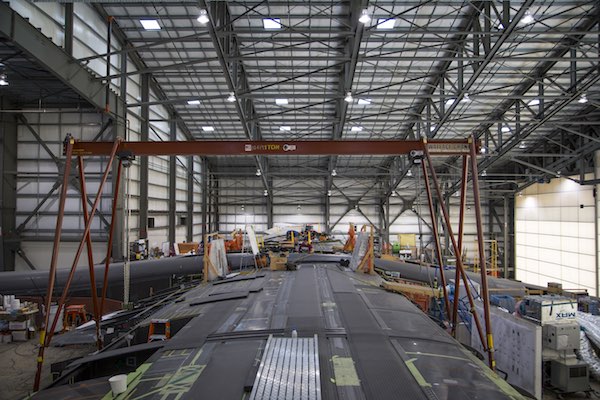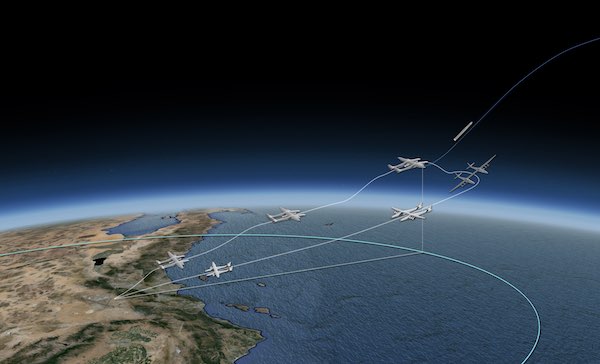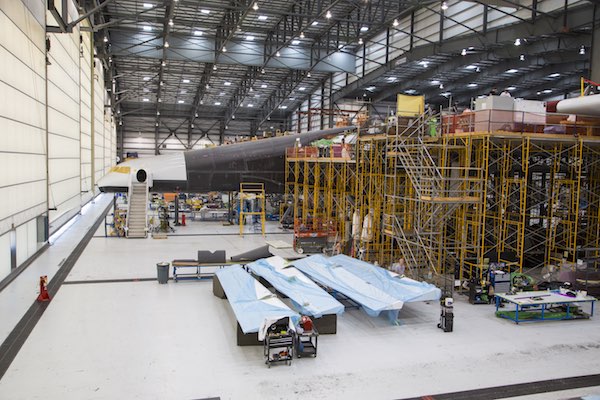Inside Stratolaunchby Jeff Foust
|
| “It has some of Burt Rutan’s DNA,” said Beames of the aircraft’s design. |
Stratolaunch, of course, isn’t building a starship or even a spaceship in its hangar at one corner of the desert airport. Instead, it is building one of the largest aircraft in the world: the largest by wingspan, at about 117 meters. That aircraft is intended to be the launch platform for—well, one or more different launch vehicles, yet to be determined, or at least announced. Even as the company’s giant airplane approaches completion, what exactly it will launch, and when, remain unknown.
 A view looking down the wing of Stratolaunch’s aircraft as seen from the center of the wing. (credit: Vulcan Inc.) |
Something old, something new
The basic details about the aircraft, called Roc, have not changed much since Microsoft co-founder Paul Allen announced plans for Stratolaunch in December 2011 (see “Stratolaunch: SpaceShipThree or Space Goose?”, The Space Review, December 19, 2011). The aircraft features twin fuselages and a giant wing, and is powered by six jet engines. The launch vehicle that Stratolaunch will carry is suspended from under the center of the wing, between the two fuselages.
The aircraft bears some similarities to White Knight and WhiteKnightTwo, the carrier aircraft designed by Scaled Composites for SpaceShipOne and SpaceShipTwo respectively. That is no accident: Burt Rutan helped design this aircraft, and Scaled is building it for Stratolaunch. “It has some of Burt Rutan’s DNA,” said Chuck Beames, president of Vulcan Aerospace and executive director of Stratolaunch Systems, during the tour.
The plane is a mix of old and new. Stratolaunch purchased two used Boeing 747 airplanes for many of their components. That includes their jet engines (six will later be installed on the plane, with the other two as spares), their landing gear, and even the cockpits. One cockpit is being installed in the right fuselage, with minor modifications, while the other is being used as a flight simulator.
Much of the rest of the airplane, though, is new construction, using carbon composite materials. “We tried to reuse as much of the Boeing 747 as we could,” Beames said, “but this is actually a very special aircraft by nature of its size.”
That posed its own challenges, particularly given the large size of some of the components. Stratolaunch constructed a separate building next door to the hangar dedicated to making the carbon composite components, one sized to the airplane’s largest parts: four wing spars each more than 62 meters long. Curing the spars required Scaled to create a mobile oven that moved along the spar given the lack of an oven big enough to hold the entire component.
At the time of the tour last week, company officials said the aircraft was about three-quarters complete: 76 percent complete, one person said, although they didn’t elaborate on exactly how that was calculated. The tail assembly, or empennage, for the left fuselage was in place, while components for the right empennage were lying on the hangar floor, waiting to be assembled and hoisted into place.
| “We tried to reuse as much of the Boeing 747 as we could,” Beames said, “but this is actually a very special aircraft by nature of its size.” |
The plane will be flown by a crew of three—pilot, co-pilot, and flight engineer—from the cockpit installed in the right fuselage. There will also be room for racks to host launch support equipment, with additional room for that equipment in the left fuselage, which will not carry any crew (most launch operations will be carried out by controllers on the ground, or autonomously by the vehicle itself.) Only the cockpit section of the right fuselage will be pressurized.
At takeoff, the plane will weigh up to 590,000 kilograms, including up to 250,000 kilograms of launch vehicle payload. The rest of the vehicle weight will be split roughly evenly among the carbon composite components, the 747-heritage components, and fuel.
While that work is going well, Beames and others at the company said, one thing about the plane might change: its name. Beames hinted he is not fond of “Roc,” given that it sounds like “rock” and doesn’t sound like something that would fly. He suggested the plane might simply become known as “Stratolaunch” going forward, although that will require some significant internal rebranding: there were a lot of signs and stickers with the Roc name on equipment in the hangar, and on shirts of the employees building the plane.
 An illustration of the concept of operations for a typical Stratolaunch mission, taking off from Mojave, launching a rocket, and returning to Mojave. (credit: Vulcan Inc.) |
Schedules and vehicles
With Stratolaunch’s plane—whatever its name—taking shape, it’s natural to ask when it might roll out of the hangar for the first time and begin what will likely be an extensive flight test program. Beames, though, didn’t offer many details. “I feel very good about where we are,” he said on the tour when asked if the plane might roll out by the end of the year.
The company is behind some earlier schedules for the plane’s development. At the December 2011 press conference, Allen and his team said the plane would start flying in 2015, with test launches starting in 2016. Beames, in an interview last summer, talked about rolling out the plane in early 2016 with flight tests beginning in the middle of the year.
In an interview during the tour last week, Beames said there was no particular technical issue delaying the schedule from those earlier announcements, beyond the fact that this first-of-its-kind plane is extraordinarily large. “I think the biggest thing is the biggest thing: it’s actually the size of the aircraft,” he said. “The folks thought long and hard about how to do that, but it turned out to be more challenging than even they anticipated.”
| “We have lots of partnership opportunities that I can’t talk about yet,” Beames said of launch vehicles Stratolaunch might use. “Who will be first? No, I don’t know who will be first.” |
Beames credited Scaled for its work on the aircraft. “They were very adaptive to challenges along the way,” he said, praising them for innovations like the mobile oven needed for producing the wing spars. “The common denominator is just building an aircraft of this magnitude. It required thinking and innovation that Scaled certainly delivered on, but a lot of those were challenges that we knew where there, but even knowing they were there, when you have to stare them in the face, it became an additional challenge.”
The airplane is just part of the overall Stratolaunch system. There’s also the launch vehicle, or vehicles, that Stratolaunch will carry aloft. Stratolaunch started in 2011 with a partnership with SpaceX, which was to provide a version of its Falcon 9. That partnership dissolved after a year, after which Stratolaunch worked with Orbital Sciences (now Orbital ATK) on a two-stage rocket dubbed Thunderbolt with a solid lower stage and a liquid upper stage powered by an Aerojet Rocketdyne RL10 engine. Both vehicles would serve medium-class payloads, like those once handed by the Delta II.
But, more recently, Stratolaunch has shown more of an interest in the growing smallsat market, spacecraft that don’t require a rocket as large as what Stratolaunch was originally pursuing. The company said last year it was looking at as many as 70 different vehicle configurations that could serve the smallsat market.
The company has yet to make any decisions on which vehicles it will use. “No company is ruled out right now,” Beames said, emphasizing that Stratolaunch will seek partnerships with these companies, rather than treat them as suppliers and subcontractors. “Because of that, we have to be very clear, very certain about the specifics of each partnership as we go.”
He declined to say if there’s a particular company in the lead to be the first launch partner. “We have lots of partnership opportunities that I can’t talk about yet,” he said. “Who will be first? No, I don’t know who will be first.”
Beames says that, whatever vehicle or vehicles Stratolaunch ends up using, they believe the company can serve emerging smallsat developers, particularly by being responsive. He talked about supporting entrepreneurs who want to build a “venture class” smallsat to prove out a technology and raising funding for a full-fledged system, as well as deploying and replenishing entire satellite constellations.
“Initially, probably, we’ll be doing at least once a month,” he said of launch rates once the system is operational. Eventually, he said, “we think we’ll be able to do this in an airport-style operation. The value there is that it’s predictability for our customers” as well as avoiding delays due to weather and competing launches on the same range.
But a shift to smallsats brings with it more competition, primarily from other systems in development. They include another air-launch system, Virgin Galactic’s LauncherOne, as well as a number of ground-launch systems, from Firefly, Rocket Lab, Vector Space, and others. They are all going after a market that, for the moment, is still somewhat speculative, as smallsat ventures primarily make use of secondary payload accommodations, including deployments from the International Space Station.
Some of those competing vehicles are further along in development than Stratolaunch: Rocket Lab, for example, plans its first launch of its Electron small rocket as soon as late this summer (a date that has slipped from the middle of the year.) Many of them plan to be flying within the next two years. And Stratolaunch?
Beames said it does discuss schedules with prospective customers, albeit under non-disclosure agreements. “We give them what our best estimate is today for a commercial service,” he said. And when might that be? “I feel very confident that we have healthy margins built into Paul’s original goal by the end of the decade,” he said. “Healthy, healthy margins.”
Of course, when Stratolaunch was unveiled in 2011—long before Beames joined the company about two and a half years ago—Paul Allen was talking about launches this year. “Were they really?” Beames asked when told about that launch date. “I wasn’t there then.”
With a billionaire backing the venture, of course, Stratolaunch can afford to be patient, taking the time to develop the right vehicle and the right partners to serve the right market, once that has changed over the last several years. “While this piece, the aircraft, we would love for it to be done today, it important that we get it right,” he said. “It’s important that we have the right discipline throughout, with inspections and all of those things, doublechecking especially some of the absolutely critical aspects of the fabrication.”
“I think it’s been worth the redoubling of attention to detail to make sure we’re getting this thing right,” he said. “In terms of the overall plan, we’re on track.”
